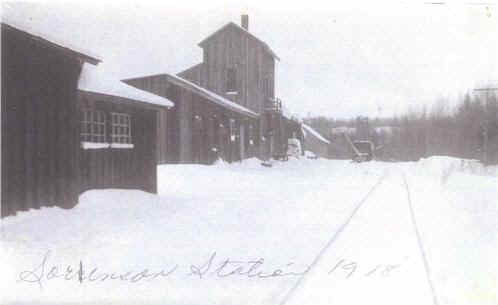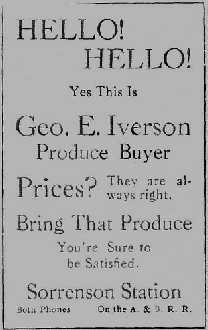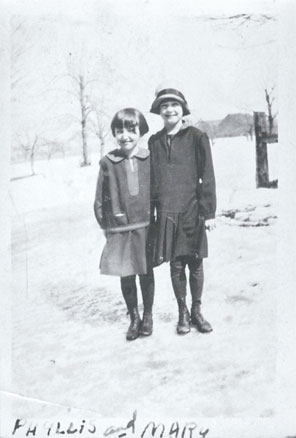The History of Sorrenson Station
An Interview with Mary Alice Grossnickle
|
The history of Sorenson Station begins with the life of the founder, Byron Burmeister of Milwaukee, Wisconsin. Burmeister was born in 1852. As a youth in Milwaukee, he worked as a deckhand on his father's sailing vessel. At twenty-three he entered into partnership with his father to carry fruit and produce from northern Lake Michigan to market in Chicago and Milwaukee. In 1885, after his marriage to Mary Talge, he purchased the schooner Mishicott and sailed with a cargo of produce to Onekama. There he continued his buying activities with local farmers and opened a store. Burmeister's buying area was greatly expanded with the construction of the Manistee and North Eastern Railroad, and he established branch stores in Tannerville and Nessen City. After 1893 he sold his schooner and began shipping by rail to eastern markets. Shortly after 1900 Burmeister operated buying stations at eight points along the Manistee and North Eastern Railroad and the Arcadia and Betsy River Railroad. The Sorenson Station was one of the stations located along the Arcadia and Betsy River Railroad as were the Malcolm, Butwell, and Saile stations, each named for a local pioneer. Sorenson Station was located near the west line of Pleasanton and Arcadia townships. Byron Burmeister operated the buying station with George E. Iverson as his agent and later partner. |
Mary Alice Grossnickle was born on October 3, 1918 in Pleasanton Township. She is the daughter of George E. Iverson and Alice Alkire of Pleasanton Township. This article is based on an interview. For Mary's recollections in her own words, see Some Memories of Sorenson Station. |
|
Early on, potatoes were key, but by 1910 beans began to take the place of potatoes. The varieties were mainly white navy beans and light and dark red kidney beans. A small elevator was built at the Sorenson Station, and cleaning and hand-picking machines were installed. As many as six women were employed to pick out the cull beans and prepare beans for sale. After 1920 George Iverson bought the Sorenson Station from the Burmeister family, and he continued the produce business until 1933. Cherry orchards replaced general farming, and an era had passed. The railroad was discontinued, the road was torn up, and the station was finally abandoned in 1937. |
See Also: Arcadia's Railroad: Key Stops along the Railway's Route: Sorenson: Vegetable Processing
|
Some Memories of Sorenson Station
|
|
|
"The Sorenson Station was an important place in the lives of the Iversons. The Charles Iverson family lived directly across the road in a house owned by Fred Sorenson, the son of A. Sorenson, an early settler of the area. The train making its daily run provided many opportunities for fun and excitement. Children placed pennies and pins on the tracks and listened for that familiar whistle as it neared the station. Both parents were employed by George E. Iverson at different seasons, as the produce was brought in by farmers and growers for sorting, culling, and packing for shipment by rail to mostly eastern parts. "The green warehouse at Sorenson Station was built for storing potatoes before shipment. Part of the building was used to preserve ice for summer use. The ice was cut from Bear Lake and hauled by team and sleighs to the station. Aunt Clara Iverson often prepared ice cream using the winter ice and a hand operated freezer. Family members fondly remember this special treat served at summer picnics. In later years the lumber from the green warehouse was used in the construction of cousin Elaine Hensen's house on Norconk road. "My father, George Iverson, sometimes went on a business trip on the A. and B.R.R. making connection with another rail line at Copemish or Henry. A story is told as follows: George's home was about a quarter mile from a railroad crossing. Dick Lang, the train engineer, was very accommodating when sometimes George was late. He waited patiently with the engine and cars at the crossing while my father came running with collar and tie in hand." |
|
|
"The steam log loader was often seen on the siding at Sorenson Station, its long boom reminding us of an accident that occurred in earlier years. During the loading of logs on a flat bed car, the boom hit the electric lines which ran near the tracks. The operator was named Cal Dunke, and he lost an arm as a result of the accident. We were told that Dick Lang, engineer of the A. and B.R.R., was married to Jennie, sister of Cal Dunke. George Hovis, a farmer resident of Arcadia, tells of helping Cal fill the bowl of his pipe after the accident. "Located at the top floor of the elevator was the room where the beans were picked. Several women were employed cleaning the culls from the beans. This was called "picking." It was a warm and cozy room with a small wood burning stove. As many as six women worked here at times. We have attempted to find the names of persons who picked beans but haven't been successful. Clara Iverson is the only one remembered. Perhaps someone who reads of Sorenson Station will know and add to our memories." |
According to John W. Martin, Calvin Dunke lost both arms at the elbows. John's grandfather, John Wass, was a classmate and friend of Cal's. "On more than one occasion, when Calvin happened to be near the Wass home at noontime, Grandpa insisted that Cal stay for the noon meal. "Calvin had two artificial forearms each covered with leather and equipped with hooks that somewhat resembled and functioned as forefingers and thumbs. As a child about five or older, I had a place at a large round table that accommodated our family of six plus Grandpa and Calvin. Needless to say, I was impressed with Calvin's ability to feed himself with his artificial fingers and forearms." -- John W. Martin |



